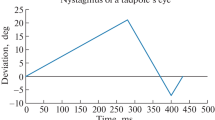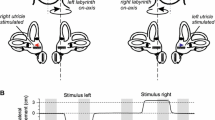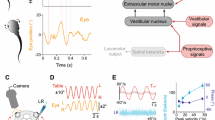Summary
-
1.
Body and ocular postural responses of restrained and freely swimming normal, bilaterally labyrinthectomized, and unilaterally blindfolded goldfish to different angles of illumination were determined by single-frame analysis of videotapes.
-
2.
In restrained normal animals ocular deviation to illumination from one side did not reach values high enough to compensate completely for the angle of incident light. The magnitude of ocular deviation elicited was even smaller than the degree of body roll induced under identical light conditions in freely swimming specimens. Similar findings were obtained with somewhat larger ocular and body responses in bilaterally labyrinthectomized and in unilaterally blindfolded fish.
-
3.
Ocular responses to passive tilt were stronger than to unilateral illumination, but did not fully compensate for the applied tilt. Illumination from the dorsal side while the animals were passively tilted reduced ocular displacements.
-
4.
Ocular responses of restrained animals to illumination from above and below were qualitatively identical.
-
5.
In restrained animals eyes deviated in response to unilateral illumination drifted back towards their normal position in the orbit when bilaterally symmetrical light conditions were provided. The ocular drift curve had an exponential shape. Bilaterally labyrinthectomized specimens needed longer periods of time to re-assume the ocular zero position than normal fish did. This difference appears to be due to higher starting values of ocular deviations in labyrinthectomized animals, as time constants of drifts were found to be around 20 s in both types of experimental subjects.
-
6.
Our data are interpreted as demonstrating the existence of CNS mechanisms counteracting sense-organ induced central tonus asymmetries.
Similar content being viewed by others
Abbreviations
- DLR :
-
dorsal light response
References
Bogenschütz H (1961) Vergleichende Untersuchungen über die optische Komponente der Gleichgewichtshaltung bei Fischen. Z Vergl Physiol 44:626–655
Bullock TH, Hamstra RH, Scheich H (1972) The jamming avoidance response of high frequency electric fish. J Comp Physiol 77:1–48
Bullock TH, Behrend K, Heiligenberg W (1975) Comparison of the jamming avoidance response in gymnotoid and gymnarchid electric fish: A case of convergent evolution of behavior and its sensory basis. J Comp Physiol 103:97–121
Easter SS (1971) Spontaneous eye movements in restrained goldfish. Vision Res 11:333–342
Fernald RD (1975) Fast body turns in a cichlid fish. Nature 258:228–229
Graf W, Meyer DL (1978) Eye positions in fishes suggest different modes of interaction between commands and reflexes. J Comp Physiol 128:241–250
Hassler R, Hess WR (1954) Experimentelle und anatomische Befunde über die Drehbewegung und ihre nervösen Apparate. Arch Psychiatr Nervenkr 192:488–526
Holst E von (1935a) Über den Lichtrückenreflex bei Fischen. Pubbl Staz Zool (Napoli) 15:143–158
Holst E von (1935b) Die Gleichgewichtssinne der Fische. Verh Dtsch Zool Ges 37:109–114
Holst E von (1935c) Die Gleichgewichtsorientierung bei Fischen. Forsch Fortschr 11:437–438
Holst E von (1950a) Die Arbeitsweise des Statolithenapparates bei Fischen. Z Vergl Physiol 32:60–120
Holst E von (1950b) Die Tätigkeit des Statolithenapparates im Wirbeltierlabyrinth. Naturwissenschaften 37:265–272
Holst E von (1954) Der Einfluss der nichtbelichteten Retina auf das Gleichgewichtsverhalten von Fischen. Naturwissenschaften 41:507–508
Meyer DL, Bullock TH (1977) The hypothesis of sense-organdependent tonus mechanisms: History of a concept. Ann NY Acad Sci 290:3–17
Meyer DL, Bonnemann D, Schaefer K-P (1973) Equalization of asymmetries of tonus in the optomotor system of rabbits. A study on oculomotor neurons. Exp Brain Res 18:505–511
Meyer DL, Platt C, Distel H-J (1976) Postural control mechanisms in the upside-down catfish (Synodontis nigriventris). J Comp Physiol 110:323–331
Meyer DL, Graf W, Seydlitz-Kurzbach U von (1979) The role of integrators in maintaining actively assumed abnormal postures. A study of postural mechanisms in geckos. J Comp Physiol 131:235–246
Precht W (1974) Characteristics of vestibular neurons after acute and chronic labyrinthine destruction. In: Kornhuber HH (ed) Vestibular system. Springer, Berlin Heidelberg New York (Handbook of sensory physiology, vol VI/2, pp 451–462)
Robinson DA (1972) On the nature of visual-oculomotor connections. Invest Ophthalmol 11:497–503
Schaefer K-P, Meyer DL (1974) Compensation of vestibular lesions. In: Kornhuber HH (ed) Vestibular system. Springer, Berlin Heidelberg New York (Handbook of sensory physiology, vol VI/2, pp 463–490)
Schaefer K-P, Schott D, Meyer DL (1975) On the organization of neuronal circuits involved in the generation of the orienting response (visual grasp reflex). Fortschr Zool 23:199–212
Scheich H (1977) Neural basis of communication in the high frequency electric fishEigenmannia virescens (jamming avoidance response). J Comp Physiol 113:181–255
Szentágothai J (1943) Die zentrale Innervation der Augenbewegungen. Arch Psychiat Nervenkrankh 116:721–760
Traill AB, Mark RF (1970) Optic and static contributions to ocular counter-rotation in the carp. J Exp Biol 52:109–124
Watanabe A, Takeda K (1963) The change of discharge frequency by A.C. stimulus in a weakly electric fish. J Exp Biol 40:57–66
Author information
Authors and Affiliations
Rights and permissions
About this article
Cite this article
Graf, W., Meyer, D.L. Central mechanisms counteract visually induced tonus asymmetries. J. Comp. Physiol. 150, 473–481 (1983). https://doi.org/10.1007/BF00609573
Accepted:
Issue Date:
DOI: https://doi.org/10.1007/BF00609573




